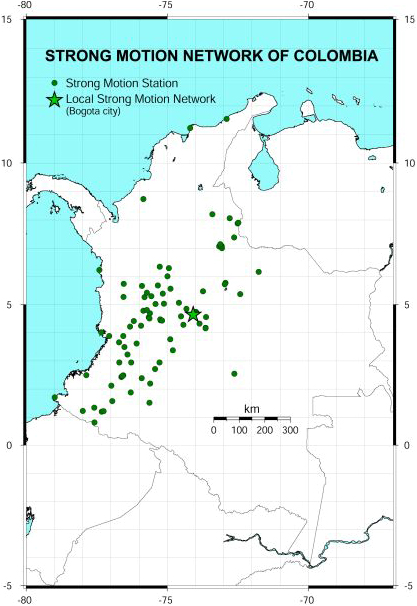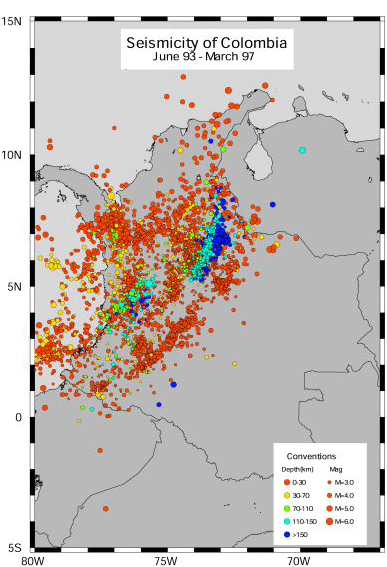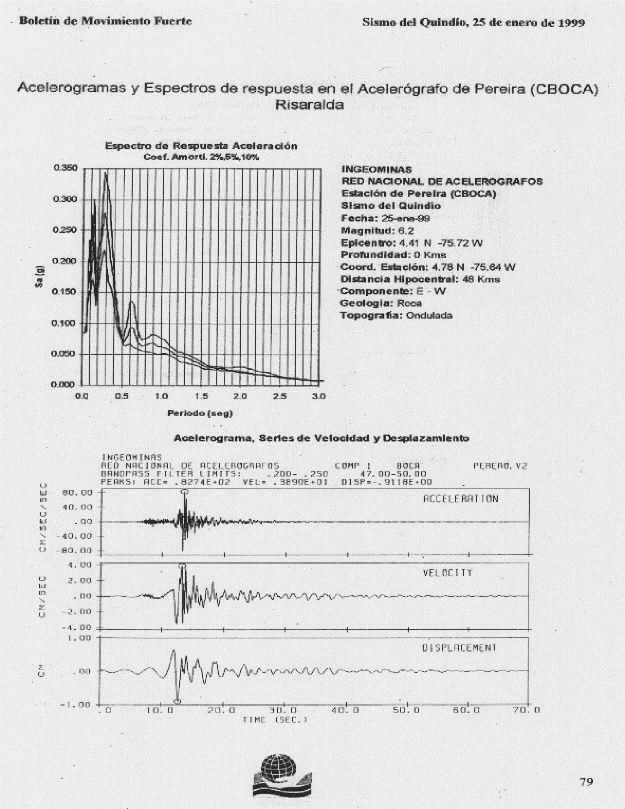第19回 コロンビアにおける国立強震観測ネットワークの7年間【英語】(Vol.12, No.5, 13-16, 2001/1)Publications
Seven years of the National Strong Motion Network of Colombia


Figure 1. (a) Distribution of stations of the strong motion network of Colombia (INGEOMINAS). (b) Seismic Activity of Colombia from 93 to 97 recorded by the Seismic National Network of Colombia operated by INGEOMINAS.
History
The first strong motion seismograph was brought to Colombia around 1950 by the Jesuit who also operated the first seismological network. It was only 4 decades later that the Strong Motion Network of Colombia was established. The institution in charge of installing and operating the network is the Colombian Geological Survey (INGEOMINAS).
The network consists of 120 digital accelerographs mainly installed in the Colombian Andean range region (figure 1a), including 30 accelerographs installed in Bogot_, the capital city. The reason for installing most of the instruments on the Andean region is because this is the main seismically active region of Colombia. This region comprises most of the active faults of Colombia, and has been classified with an intermediate to large seismic hazard. The remaining regions in Colombia, especially to the south-east (Amazon plane), have almost no seismic activity (figure 2b).
The network was planned in two phases; the first phase that started in 1993 consisted of the installation of 35 stations in two years and the second phase 55 stations to be installed in another two years. The first phase of the network was sponsored by the Canadian International Development Agency (CIDA) and the United Nations. The second phase was sponsored by the Colombian government through the National Agency for Disaster Prevention. Most of the funding was spent in obtaining the strong motion seismographs. For sponsoring the construction of about half of the housing of the instruments an agreement was reached between INGEOMINAS and the local municipalities.
Several institutions were also engaged to the strong motion network by giving INGEOMINAS the operation of their strong motion instruments. This is the case of several hydro-electrical projects, cement industries and regional agencies for development.
In addition to the original 90 instruments of the national network, in 1997 started a project to setup a local network of 30 accelerographs for Bogot_, the capital city of Colombia. The local strong motion network of Bogot_ was sponsored by the Disaster Prevention city office (DPAE) and is operated by INGEOMINAS.

Figure 2. Typical output of the Strong Motion Catalog published by INGEOMINAS. The waveforms correspond to the 1999 Quindio earthquake recorded in a rock site station.
Instrumentation
The total number of accelerographs of the national network and the Bogot_ local network is digital, produced by Kinemetrics, with various resolutions from 12 to 19 bits. The network consists of free field instruments, and two borehole instruments located in Bogot_ and one in Tumaco cities. The borehole instruments consist of 6 sensors located at the surface and at depth of 200 m. The network also operates a set of strong motion instruments to be used for aftershocks observation after a large event. Approximately half of the stations are located in rock sites.
Purpose of the Network
The main purpose of the network is to carry out the observation of strong earthquakes that happen in the main seismic active regions of Colombia. To study the ground motion attenuation and source rupture characteristics of large events. To publish the Colombian catalogue of strong ground motion. To make aftershocks observation after a large event.
Recordings
Since the beginning of operation of the network more than 900 accelerograms from 70 earthquakes with various magnitudes have been recorded. All the information produced is processed and stored in a database. A catalogue of the strong motion information is published every year. The catalogue contains the acceleration, velocity and displacement time histories for every recording and also the acceleration response spectra. A typical output of the catalogue can be seen in figure 2.
Future Plan
The future projects of the National Strong Motion Network of Colombia are to study the site effect at every station by measuring the P and S wave velocity. A project that is currently under way is the implementation of a strong motion database that allows the user to consult the strong motion catalog through the Internet.
The Strong motion network of INGEOMINAS can be reached at:
http://www.ingeominas.gov.co/red/red_de_acelografos/red_de_acelerografos.htm
References
INGEOMINAS (1995) Boletin de Movimiento Fuerte Noviembre1993-Octubre 1995, Vol.1 No.1.
INGEOMINAS (1996) Boletin de Movimiento Fuerte Noviembre1995-Octubre 1996, Vol.1 No.2.
INGEOMINAS (1999) Boletin de Movimiento Fuerte Volumen Especial Sismo del Quindio Enero 25 de 1999.

